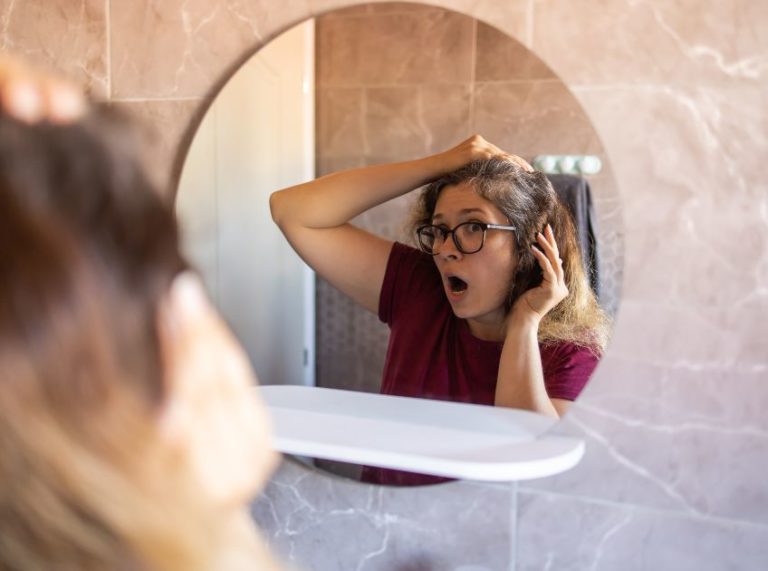
Important: This article is for informational purposes only. Please read our full disclaimer for more details.
Practicing a hair care regime takes you one step closer to healthy hair. As the beauty world evolves, multiple products launch in the market, promising to make hair stronger, shinier, and healthier. At the same time, you can find a variety of shampoos and conditioners suitable for different hair types.
Even if you have the best shampoos and conditioners, it is essential to use them in the right ways to achieve maximum benefits. If you start searching for ways to use these haircare essentials, you will stumble upon many different results, one of which is leaving the conditioner in your hair for 30 minutes. Since conditioner is used after shampooing, many women consider adopting this method.
If you wonder what happens if you leave the conditioner in your hair for 30 minutes, continue reading to find out!
Conditioner

Conditioner is a haircare product that contains emollients, humectants, and oil (1). Humectants help attract and maintain moisture to keep the hair hydrated, which prevents dryness and frizz. On the other hand, emollient prepares a protective layer that locks in moisture and prevents dehydration, keeping the hair soft and smooth (2).
Conditioner is usually used after you shampoo your hair. While shampoo removes excess oil, grime, and dead skin cells and cleanses the scalp, conditioner makes the hair more soft, shiny, and manageable. It does so by forming a layer around the hair follicle to protect it against any kind of damage.
To understand what happens if you leave conditioner in your hair for 30 minutes, it is essential to know there are two types of conditioners-
- Regular conditioners: The regular conditioner is the one that we use after using shampoo and rinse immediately after a few minutes. This conditioner helps in strengthening and maintaining the hydration of the hair.
- Leave-in conditioners: They are formulated in a way that they can be left on the hair until the next wash. Leave-in conditioners are light in weight and do not weigh down the hair. It is good to add shine and softness to the hair, making it more manageable during hair styling. Additionally, it also helps in detangling the hair without causing any breakage.
Using Conditioner for Maximum Benefits
Irrespective of how branded or expensive conditioner you have, until you don’t know how to use it correctly, it will not give the desired results. Following are the steps to use a regular conditioner correctly-
- Cleanse the scalp and hair using a gentle shampoo and rinse it thoroughly.
- Apply the conditioner to sections of hair to ensure proper application.
- Apply it from the mid-length of the hair till the ends. Do not use conditioner on the scalp.
- Distribute the conditioner evenly to cover every hair strand.
- Let the conditioner sit for 2-3 minutes.
- Rinse it using regular or cold water.
Can You Leave the Conditioner in Your Hair for 30 Minutes?

Now, coming to the query, if you are using a regular conditioner, it is advised not to keep it in your hair for longer than recommended (usually, 2 to 3 minutes). You need to rinse it a few minutes after it is applied to the hair.
Many women believe that since conditioner softens the cuticles and makes hair shiner and more manageable, the longer they keep it, the better will be the results and give deep conditioning. Conversely, doing so can cause more harm than help.
Keeping the conditioner for 30 minutes in your hair may start to have a negative impact, such as:
- Clogged Pores: Conditioner clogs pores when kept for longer. It happens because product build-up blocks the hair follicles that over time may result in different scalp issues and hair fall. Scalp can become inflamed and irritated, resulting in weak roots that eventually fall off.
- Oily Hair: When conditioner is kept for longer than recommended, it can lead to over-moisturizing, especially if you have fine or oily hair. As a result, the hair weighs down that makes them look flat, limp, and greasy.
- Attracts dirt: Leaving conditioner in hair for too long attracts grime and dust to the scalp. It usually happens when you come in contact with dirty surfaces such as clothing, pillows or furniture when the conditioner is in. Such scalp would pick up dirt particles more easily than if it were clean.
- Scalp Irritation: As the hair follicles get blocked, the chances of them getting inflamed increase over time. As a result, the scalp starts itching and causing irritation.
Conclusion
A conditioner is an essential product that helps to keep hair smooth, healthy, and manageable. Every product, when used within its recommended limits, benefits hair.
So, keeping a conditioner in your hair for 30 minutes is a bad idea, especially if it is a regular conditioner. On the other hand, if you are using a leave-in conditioner, you can keep it for over 30 minutes or as directed in the instruction manual.
Image Source : canva
Related Articles
- 7 Best Conditioners For 4C Hair
- 7 Best Conditioners for Blonde Hair
- 7 Best Deep Conditioners For Curly Hair
- 7 Best Leave-In Conditioners For Low Porosity Hair
- 7 Best Leave-In Conditioners For 4C Hair
- 7 Best Shampoos And Conditioners For Straightened Hair
- Why Is My Hair So Dry Even With Conditioner?
- Everything You Want To Know About 2 In 1 Shampoo And Conditioner
- 7 Best Shampoos And Conditioners For Black Hair Growth
- Do You Use Shampoo Or Conditioner First?















